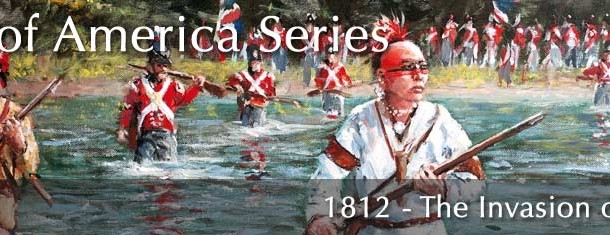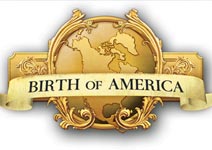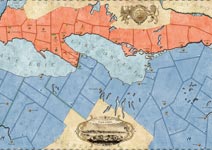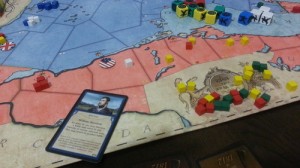By Harvey Mossman and Fred W. Manzo
1812: The Invasion of Canada Variants
In our opinion, Academy Games’ 1812: the Invasion of Canada is a popular game because of simple and elegant play mechanics and Eurostyle treatment of the campaigns along the United States – Canadian border during the War of 1812.
We’ve played it many times and, despite its numerous likable aspects, we’ve found that it is definitely imbalanced in favor of the British. In fact, with competent British play, we have never seen an American victory. Now this may have been the designer’s intent as the British did have several advantages over a poorly organized opponent fighting an unpopular war. However, as this game may serve as an introduction for non-wargamers to our hobby, it behooves us to restore its balance as both new and old players like games that give them some chance of winning.
I want to make it clear at the outset that we are not trying to disparage an enjoyable design. We’re only suggesting fixes to play imbalance as this game is going to serve as the flagship of an ongoing series.
Let’s start the discussion with a look at the British advantages.
Numeric Factional Advantage Yields Superior Strategic Movement
The British have three factions, while the Americans have only two. As you’re able to move an Army as long as one unit of a faction is present, the British players have a tremendous flexibility and strategic mobility advantage over the Americans as they may move three times per round against the American’s two. The only requirement being that the Brits keep their armies populated with all three of their factions and this isn’t a particularly difficult requirement.
The British player is also much more likely than the American to move two or even three times in a row. Over a two round span the chances are just shy of 60% that the Brits will have three consecutive moves (this may include moves from a previous round.) This is a tremendous advantage especially if you take into account that the player who makes the last move in this game has the ability to seize victory point objectives without worrying about a response from his opponent. In fact, this last turn victory point grab is how almost all of our games terminated in a British victory.
Home Defense Rule
The Home Defense Rule aggravates the problem of consecutive moves. In a typical example, the Americans invade a British homeland territory. They are then subjected to fire before they shoot back. Therefore they are likely to take heavier initial losses. Plus they usually must withstand consecutive counterattacks by the British player who again fires first due to the Homeland Defense Rule when his next faction moves and his next faction moves.
While it is quite common for the American player to invade Canada with a large army only to suffer initial substantial losses and then be counterattacked two or three times before he even has a chance to reinforce his position or retreat, the reverse isn’t always true. Although the British also suffer homeland defensive fire when they invade the United States, they are more likely to reinforce any captured territory before their army evaporates due to their propensity to move consecutively.
Muster Area Advantage
British Muster Areas are closer to the front line than the American Muster Areas and more numerous (three printed on the map or four if you count the special Native American ability to recruit anywhere a Native American unit is present). While some say this makes British Muster Areas more vulnerable, the discussion above clearly demonstrates the difficulty of the American successfully holding Canadian territory. The net effect is that British Fleeing units reappear right in critical defensive positions, while the American Fleeing units both disappear from the fight for two or three turns and absorb precious resources getting back to their front line.
Numerical Superiority
The British simply have more units than the Americans in their force pool. The British have 25 Regulars, 35 Canadian militia and 25 Native American units to call on. The Americans, on the other hand, have only 30 Regulars and 45 militia units, for a total of 85 British units to 75 American units.
Combat Qualitative Superiority
The British Army is qualitatively better than the American army. This advantage derives from two factors: the number of Hits, Command Decisions and Flee results on British dice compared to American dice and the fact that the British Army can roll a maximum of 8 dice in combat, (2 for British Regulars and 3 each for the Canadian Militia and Native Americans) compared to the American’s 5, (2 for the American Regulars and 3 for the American Militia). The breakdown of possible results based on the individual dice each faction throws is depicted below.
| Possible Combat Die Roll Outcomes Based On Faction | |
|---|---|
| British Regulars: | Produce hits 3 out of 6 attempts, flee 0 times out of 6 and 3 out of 6 times generate Command Decisions |
| American Regulars: | Produce hits 3 out of 6 attempts, flee 1 time out of 6 and 2 out of 6 times generate Command Decisions |
| Conclusion: | The British regulars flee less and generate more Command Decisions than their American counterpart |
| American Militia: | Produce 2 hits out of 6 attempts, flee 2 out of 6 times and 2 out of 6 times generate Command Decisions |
| Canadian Militia: | Produce 2 hits out of 6 attempts, flee 2 out of 6 times and 2 out of 6 times generate Command Decisions |
| Conclusion: | American and Canadian Militia are equivalent in combat |
| Native Americans: | Produce 2 hits out of 6 attempts, flee 1 out of 6 times, 3 out of 6 times generate Command Decisions, plus in most cases they generate 3 extra die rolls per battle, give the British an extra movement phase and have a “floating” muster area |
| Conclusion: | Native Americans are in many ways better than American Regulars! |
As you can see from the table above, the British Army is qualitatively superior. They flee less often and have a better chance of producing Command Decisions, which makes them tactically more flexible as they have a greater chance of staying in an advantageous position or leaving in a losing situation.
Native American’s Special Command Decision Ability
But that’s not all! The Native Americans can “retreat forward.” That is when a “Command Decision” is rolled Native American troops have the opportunity to “retreat” into unoccupied American territory, even if it’s a victory point site. Additionally, the rules state that movement of the Command Decision units is sequential. Therefore, a Native American can move into an unoccupied American territory from a Command Decision result and then be followed by a British regular or Canadian militia Command Decision in the same round of combat! This means that the Americans must have a defense in depth or else suffer from a savvy British player’s “retreating” ever deeper into their territory. Think of what this can do to a game that is about to end because the last Truce card has been played. It is particularly devastating if the British are moving consecutively, as it is likely that by “retreating forward” they’ll be grabbing victory point spaces as they go.
The Americans simply cannot be expected to be everywhere.
Geographic Advantage
Both sides must defend 7 land crossings but the Americans are vulnerable along the Hudson River due to the potential for a large British Army to debouch within two spaces of Albany (a Muster Area) by play of a Warship card. Therefore, the Americans have to defend all the usual crossings, plus the Hudson River crossings. The British have no corresponding geographical problem.
Conclusions
So what’s not to like about the British position? They have a qualitatively superior Army in combat, are more flexible strategically and tactically, are more likely to move consecutively and, more importantly, are more likely to move last. In addition, they have more troops to call on and they are likely to hit more often when in battle. Plus, they have a geographic advantage as to the placement and number of their Muster Areas in comparison to the vulnerabilities of the American Muster Area along the Hudson. In essence, the British player can fight the American player to a Draw for most of the game and then use their advantages to surge into American victory point areas just before or after the play of the last Truce card. And remember, they can do this while not overly worrying about an American response.
Surely, the Americans must have a few tricks up their sleeves? Well, their movement cards do tend to allow more of their armies to move in a round but this does not begin to compensate for the British advantages. Some also will say that their Muster Areas are arguably more difficult to capture as they are deeper in their home territory. However, given the vulnerability of Albany by a British Hudson River invasion and the fact that the Americans must spend resources to bring forces forward negates this advantage in our opinion.
Now, we’re certain that if we played an infinite number of times the Americans would eventually win. But really, is that the measure of a balanced game? Also, do you really want to introduce new wargamers to our hobby with a game so imbalanced that one side has almost no chance of winning? Surely we’d have stopped playing Monopoly very early on if we knew there was no reasonable possibility of us ever winning even one game.
Proposed Rule Changes In Our Variant
1. Turn Order Mulligan
Once each round, the American player may throw back into the bag the faction order cube just selected. He only gets to do this once each round. If he throws a cube back and it is immediately selected again, the players must make the move with this faction. (He cannot use this rule to avoid moving first in the first round of the game.) This rule partially offsets the British consecutive movement advantage as the American player will have a limited ability to break up advantageous British moves and it does provide some interesting decision-making for the American player.
2. Native American Fear Of Fortifications
In our opinion the Native Americans are some of the best troops on the board given the fact that they are better than the American Regulars qualitatively and have the special Command Decision ability. This rule helps lessen that advantage. Simply put, when Native Americans are involved in combat in an American Homeland Victory Point Territory, they must treat all command decision results as Flee results. Also, they may never use their special command decision ability to occupy an unoccupied American Homeland Victory Point Territory. When performing normal movement, they may move into these territories normally.
3. Reluctant Militia
Canadian and American militia were often reluctant to serve outside their countries. Whenever any Militia faction attempts to move across their national boundary to enter an enemy Homeland Territory, they must roll one of their faction die for each militia unit. If the result is “Flee” the militia unit must stop in the last area entered and remain behind while the rest of the Army completes its movement into enemy territory. Militia units thus left behind may move no further in this activation but may in a subsequent faction move with the same “Reluctant Militia” restrictions. This rule applies even if the militias are crossing the national boundary via water movement. Note that this rule only affects movement across national boundaries. It does not affect militias who have already successfully entered the enemy’s country. They maneuver normally once across the border.
While some may think this rule primarily affects the American player who has more militia and is more dependent on them, in actuality it affects the British to a much greater extent as they tend to have fewer regular troops and it does place some limits on their last turn ability to surge across the border in massive numbers.
4. Reshuffling of Played Cards
In our opinion the American special cards are more powerful than the British ones. Therefore re-circulating them is advantageous to the American player. Under this rule, all cards that have been played are reshuffled into each faction’s deck at the beginning of each new round prior to that faction filling his hand. Truce cards and the British warship card are never reshuffled and can only be used once. Additionally, the British factions must randomly select one Special Card used in the current round to remove permanently from the game before reshuffling the rest of their cards and filling their hand. The net effect of this is to preserve the American factions’ flexibility, while slowly draining the British players of their special abilities. In our opinion, this will force the British to end the war quickly. Remember at this time there was unrest in the Caribbean and a war in Europe to fight against Napoleon. Even after his abdication, Europe remained unsettled and the British public was extremely war weary. Therefore, there was a great deal of pressure to prosecute this war to a conclusion.
5. Hudson River Invasion Early Warnings
The Americans would surely have had an early warning of a British invasion fleet making its way slowly down the Hudson. Therefore, immediately following any move by the British player that uses a water movement card on the Hudson River, the American player may make an immediate special move by one of his armies within three spaces of the Hudson. This Army must end its movement in an American Homeland territory adjacent to the Hudson River. This move does not require the play of a card and will occur as a special reaction in the British faction’s move. If this special American army move ends in a British occupied American homeland territory, combat proceeds as normal.
6. Revised Homeland Defense Rule
The player in his home territory no longer automatically fires first. The defender fires first with all of his factions but the Homeland advantaged player designates the faction that must take the first enemy casualty. After this first exchange, all fire is simultaneous but the player who is fighting in his homeland territory decides who resolves Command Decisions first for the rest of the combat.
While this rule does not fully negate the great advantage of battling in one’s Homeland Area, it somewhat mitigates it. Now a defender can inflict some casualties before the attacker fires on him while the Homeland advantage affects how combat results are implemented.
7. Reduced Native American Combat Effectiveness
In this game, the Native Americans are the second best troops right behind the British Regulars. This combined with their special Command Decision ability and their power to recruit in areas already occupied by other Native Americans make them disproportionately effective. Therefore we took the simple option of reducing their maximum number of combat dice to 2 instead of 3. Although Native Americans were an important contingent for the British, they were far less effective in stand up battles and certainly much less effective against fortified settlements. We believe this simple rule reflects their true combat effectiveness.
Summary
Taken as a whole, these rule changes are meant to improve an already innovative design. While we could not possibly playtest every ramification of these changes, we found they do serve as welcome help to beleaguered American players and they even add some interesting decision-making to the game. Please let us know what you think.
Game Resources
1812: The Invasion of Canada page (Academy Games)












